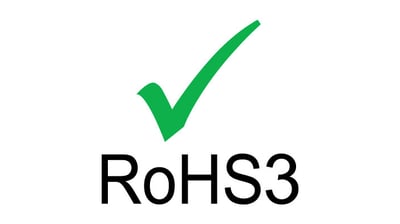Working in the manufacturing industry, you’ve probably noticed the letters RoHS or REACH on various documentation or even browsing our website. But, have you ever wondered what these letters stand for or what the certification that comes with them entails?
Essentially, RoHS bans substances present in electrical/electronic equipment such wiring, components, circuit boards, displays, and/or sub-assemblies and REACH controls all chemicals that might be used to manufacture the product including enclosures, brackets, coatings, paints, solvents, and chemicals used during manufacturing. Both of these regulating bodies hold manufactures accountable for producing products of the highest quality while being conscious of their effects on the environment.
RoHS - Restriction of Hazardous Substances
In 2003, the European Union introduced RoHS, which stands for the Restriction of Hazardous Substances. RoHS prohibits the use of certain hazardous materials found in electrical and electronic components. As you can imagine, this directly affects our business on a day-to-day basis. Current and potential customers often require that the products we produce here at Epec comply to the RoHS certification. These substances are harmful to the environment, and exposure to them can be very dangerous for the people building, handing, and recycling the products.

The substances that RoHS forbids are lead, mercury, cadmium, hexavalent chromium, polybrominated biphenyls, and polybrominated diphenyl ethers.
RoHS 3, or Directive 2015/863, was published in 2015 by the European Union and includes four additional restricted substances (phthalates) to the original list of six, as cited under REACH legislation.
REACH - Registration, Evaluation, Authorization and Restriction of Chemicals
Another regulation that we are seeing being adopted more and more here in the United States is REACH. REACH stands for the registration, evaluation, authorization and restriction of chemicals. This regulation began in 2006 and addresses the production and use of chemical substances and their potential impacts on both human health and the environment.
You may be wondering how this differs from RoHS compliance since they both involve chemicals. REACH is a more general regulation and is monitored by the ECHA (European Chemicals Agency) and deals with 197 substances of very high concern (SVHC). While RoHS bans substances present in electrical/electronic equipment, REACH controls all chemicals that might be used to manufacture a product, including enclosures, brackets, coatings, paints, solvents, and chemicals used during manufacture.
To be considered as a substance of very high concern, a substance will meet one or more of the following criteria:
- Class 1 or 2 carcinogen, mutagen, or toxic for reproduction (CMR)
- Substance which is PBT (persistent, bio-accumulative and toxic) or vPvB (very persistent and very bio-accumulative)
- Other substances for which there is evidence of equivalent degree of concern (example: endocrine disruptors)
The list of these substances has grown by an average of 35 substances a year since 2008, and by 2020 the ECHA has committed to having all currently known SVHCs on the list.
With more and more customers looking to comply to REACH, Epec’s engineering team currently confirms whether an existing product we make does indeed meet REACH compliance. We do this by contacting the various vendors from whom we buy components from and asking for written statements of compliance so that we can prove that none of the SVHC are in our products.
Summary
Both RoHS and REACH regulations apply to any businesses that sell products, subassemblies, or components directly or indirectly to countries within the European Union. It is very important that as a company we understand these regulations and what they entail. Epec has a responsibility to comply with these regulations because whether our customers are located in Europe or whether they buy our products and use them as part of a larger product, we must be conscious of our environment and people who come into contact with our products. This way we ensure that the world we live in is healthier and that our customers’ lives are made better not worse when using our products.
Key Takeaways
- RoHS and REACH regulations ensure product safety and environmental responsibility: RoHS restricts hazardous substances in electrical and electronic equipment, while REACH regulates all chemicals used in manufacturing processes, including coatings, paints, and solvents.
- RoHS compliance directly impacts electronic manufacturing: Introduced by the European Union in 2003, RoHS bans substances such as lead, mercury, cadmium, and hexavalent chromium, ensuring that electronic components are safer for both people and the environment.
- REACH addresses a broader scope of chemical regulations: Unlike RoHS, REACH controls 197 substances of very high concern (SVHC), including carcinogens and endocrine disruptors, to reduce their impact on human health and the environment.
- Epec ensures compliance with RoHS and REACH by working with vendors: Epec’s engineering team verifies compliance by obtaining written confirmation from suppliers to guarantee that none of the restricted substances are present in its products.
- Understanding and complying with RoHS and REACH is essential for global trade: Any company selling products or components within the European Union must meet these regulations, reinforcing the importance of environmental responsibility and product safety in modern manufacturing.
















